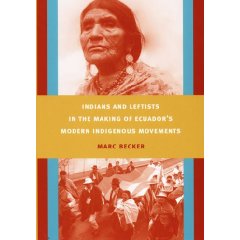
| The Book |
| Chronology |
| Acronyms |
| Glossary |
| Biographies |
| Revolts |
| Documents |
| Data |
This is an Electronic Appendix of documents to accompany my book Indians and Leftists in the Making of Ecuador’s Modern Indigenous Movements (Duke University Press, 2008).

The American Historical Review 114, no. 4 (October 2009): 1127–1128.
Reviews of Books
Caribbean and Latin America
Marc Becker. Indians and Leftists in the Making of Ecuador's Modern Indigenous Movements. (Latin America Otherwise: Languages, Empires, Nations.) Durham, N.C.: Duke University Press. 2008. Pp. xxv, 303. Cloth $79.95, paper $22.95.
Erin E. O'Connor
Bridgewater State College
The Confederation of Indigenous Nationalities of Ecuador (CONAIE) is one of the most prominent and successful Indian organizations in contemporary Latin America, and its emergence as a major political player in national politics has generated unprecedented scholarly attention for this small north Andean nation. However, few scholars have searched earlier than the 1960s for the foundations of modern Ecuadorian indigenous movements. They claim that earlier indigenous actions in the highland regions were focused on class rather than ethnic problems, and that non-Indian leftist leaders set the agenda for rural protests, treating indigenous peoples in a paternalistic manner. Marc Becker's book takes issue with this historical interpretation and traces indigenous activism back to the 1920s, asserting that “Ecuador has a longer and more diverse history of Indigenous movements engaging issues of gender, class, and ethnicity than most scholars and activists realize” (p. 16). He proposes indigenous activists and urban leftists forged an egalitarian alliance before the mid-1950s, in which they addressed ethnic as well as class problems and goals.
The book treats three distinct phases in the development of indigenous protests and strategies. From the 1920s-1950s, indigenous hacienda workers and leftist intellectuals (mostly from the Communist Party, or PCE) were natural allies against governments in which even those charged with protecting Indians typically sided with large landowners to perpetuate exploitative capitalist and racial systems. Leftist politics provided language that allowed indigenous leaders to put their struggles in a broader context, and PCE support influenced indigenous protestors to move from levantamientos (uprisings) against specific grievances to strikes demanding structural changes on large estates. This relationship resulted in the 1944 formation of the Federation of Ecuadorian Indians (FEI), which worked to address indigenous problems on a national scale. By the 1950s, leftists and Indians began to drift apart: leftist intellectuals focused on anti-imperialism, while indigenous activists sought land reform. It was in this period, Becker argues, that leftist leaders assumed a paternalistic stance with Indians and downplayed the impact of racism on capitalist exploitation, even though the 1964 and 1973 agrarian reform laws brought unprecedented public attention to race. The FEI was not able to develop new political tactics mandated by this more overtly racialized political atmosphere and went into decline. Becker notes that “activists outgrew the FEI” (p. 156) as a natural part of the evolution of indigenous activism. This led to a new and more overtly ethnic period of indigenous activism in the 1980s, culminating in the formation of CONAIE as an umbrella organization for the various highland and lowland regional indigenous movements.
Although Becker considers an impressive time span, his reinterpretation of the 1920s-1950s is at the heart of this book; it is in these chapters that he makes his most compelling, provocative, and occasionally problematic arguments. Central to Becker's overall argument in the book is his assertion that indigenous leaders and leftist intellectuals enjoyed an equal partnership from the 1920s to 1940s that reinforced and strengthened each movement. Becker demonstrates that PCE leaders, particularly Ricardo Paredes, took the work, wisdom, and wishes of now famous indigenous leaders like Jesús Gualavisí and Dolores Cacuango quite seriously. He adeptly breaks down the myth that the FEI was simply a peasant wing of the PCE, making a strong case that indigenous peoples set much of the FEI agenda before 1960. What I find less convincing is Becker's argument that the PCE-indigenous relationship was egalitarian. His evidence for this is sometimes thin, and given the centuries of white-mestizo paternalism toward indigenous peoples I am skeptical that leftist intellectuals could completely discard stereotypes of Indians, despite their desire to build true partnerships with indigenous leaders. A more nuanced analysis of the achievements and challenges in working to overcome interethnic paternalism would have been more compelling. Similarly, while I think that Becker is correct that ethnicity informed indigenous peoples' class-based demands from the 1920s to the 1950s, he often left me wanting more specific details to support his point. I also wondered how deeply FEI influence was felt in the central and southern highlands, beyond its base in Cayambe (just north of Quito), particularly since central highland activists seemed slower to adopt new protest tactics.
However, if Becker has not entirely convinced me that interethnic paternalism was absent from Indian-PCE encounters, he has convinced me that it was not absolute, and that the two groups enjoyed a mutually beneficial relationship that made possible the formation of modern, nationwide indigenous activist movements. This book is an important read not just for Ecuadorianists, but for anyone interested in the history of Latin American social protest movements. Becker plays a key role in breaking down the arbitrary barrier between class and ethnicity in scholarly analyses of indigenous movements.